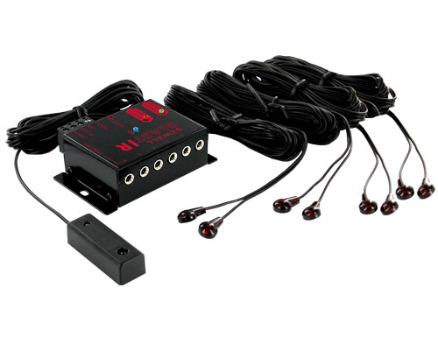IR Blaster. IR Emitter. IR Cable. They all refer to the same thing, the thing you see at the top of this article. Technically the “blaster” part is the box while the “emitter” is the thing at the end of the “cable.” But hey, let’s not get to far into the woods. The whole point of an IR Blaster is to give you control over something you can’t see.
How this stuff works
An IR Blaster works the same way a remote control does. In fact, the “bulb” end of an IR Blaster has the same sort of infrared LED that a remote does. Just place it in front of the thing you’re trying to control and it sends the same signal that your remote does. There are a few differences if you get picky, though, and it’s worth mentioning them.
In some cases, like the Sewell product you see above, one blaster can go out to multiple products. This is perfect for a situation like multiple receivers or devices in a rack. It means you don’t need one blaster per product. Also it’s worth pointing out that the output of an IR blaster is usually quite a bit weaker than that of a regular remote control. The emitter “eye” shouldn’t be more than a few inches away from the thing you’re trying to control.
Where does the signal come from?
Where it gets those signal depends on your setup. In years past, you would get that signal from some sort of remote extender like the NextGen Remote Extender. A device like that uses a tiny device that takes the place of one of your remote’s batteries and converts its infrared signal to radio frequency (RF) so that it can go through walls, doors, or cabinets.
Lately, it’s more common to see this sort of thing used for devices that aren’t smart home capable. The little box you see above you is a Wi-Fi enabled IR blaster. It connects to your Wi-Fi so it can take commands from an app or from a voice assistant like Alexa. That command is translated into infrared. Then it’s blasted out the front of the device.
Other uses for IR blasters
IR blasters are also used in RVs sometimes to let you control equipment in the back, but it’s really the same scenario — you’re trying to control something without physically looking at it.
IR blaster cables come in different lengths and different designs, but most of them use the same 1/8″ TRS plug (like a headphone). The one you buy depends on the length of cable you want and the shape of the emitter, which would let you control more than one thing at a time if properly aimed.
Get what you need from Solid Signal
Solid Signal is your source for thousands and thousands of parts. Each one is designed to help you live your best digital life. From tiny accessories to massive rack systems, we have you covered. Best of all, we’re here for you! I mean before, during, and after the sale. Unlike a lot of those larger vendors we actually pick up the phone. Even better you’ll get access to a real trained technician. Our staff doesn’t live overseas or read scripts. We’re based in southeastern Michigan, not Southeast Asia. Don’t believe me? Call us at 888-233-7563 and let us show you what real customer service is about.





